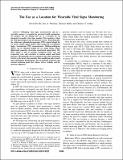The ear as a location for wearable vital signs monitoring
Author(s)
He, David Da; Winokur, Eric S.; Heldt, Thomas; Sodini, Charles G.
DownloadHe-2010-The ear as a locatio.pdf (1.813Mb)
PUBLISHER_POLICY
Publisher Policy
Article is made available in accordance with the publisher's policy and may be subject to US copyright law. Please refer to the publisher's site for terms of use.
Terms of use
Metadata
Show full item recordAbstract
Obtaining vital signs non-invasively and in a wearable manner is essential for personal health monitoring. We propose the site behind the ear as a location for an integrated wearable vital signs monitor. This location is ideal for both physiological and mechanical reasons. Physiologically, the reflectance photoplethysmograph (PPG) signal behind the ear shows similar signal quality when compared to traditional finger transmission PPG measurements. Ballistocardiogram (BCG) can be obtained behind the ear using 25mm×25mm differential capacitive electrodes constructed using fabric. The BCG signal is able to provide continuous heart rate and respiratory rate, and correlates to cardiac output and blood pressure. Mechanically, the ear remains in the same orientation relative to the heart when upright, thus simplifying pulse transit time calculations. Furthermore, the ear provides a discreet and natural anchoring point that reduces device visibility and the need for adhesives.
Date issued
2010-08Department
Massachusetts Institute of Technology. Department of Electrical Engineering and Computer Science; Massachusetts Institute of Technology. Department of Mechanical Engineering; Massachusetts Institute of Technology. Research Laboratory of ElectronicsJournal
Annual International Conference of the IEEE Engineering in Medicine and Biology Society, 2010. EMBC 2010.
Citation
Da He, David et al. “The ear as a location for wearable vital signs monitoring.” IEEE, 2010. 6389-6392. Web. 3 Feb. 2012. Da He, David et al. “The ear as a location for wearable vital signs monitoring.” IEEE, 2010. 6389-6392. Web. 3 Feb. 2012.
Version: Final published version
Other identifiers
INSPEC Accession Number: 11660144
ISBN
978-1-4244-4124-2
ISSN
978-1-4244-4123-5
1557-170X